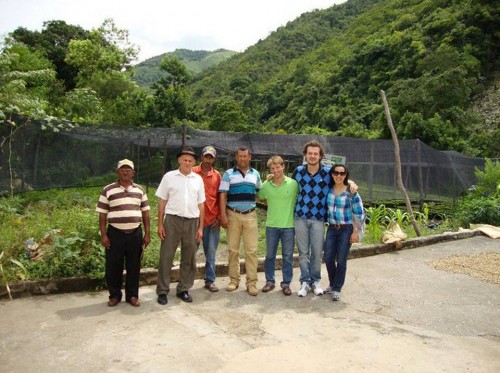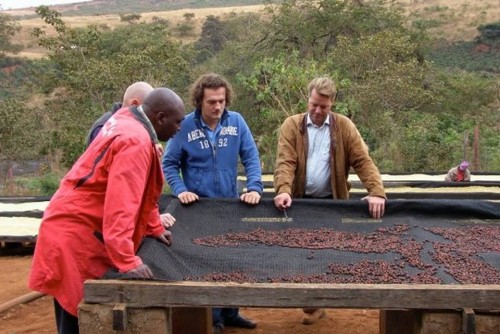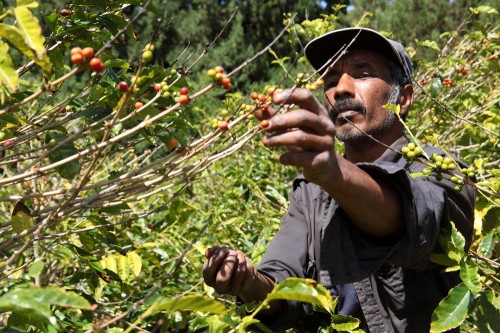Let us know what you think of The Coffeevine – Annual survey call!
We’re looking for in-depth feedback and insights from our global customer and fan base. Win awesome prizes in return for your time!
A few weeks ago I was invited to a cupping event at HeadFirst Coffee Roasters where a guy called Lennart Clerkx was going to present some Rwandan coffees to industry experts and coffee lovers like you and me. I wasn’t sure who this Lennart guy was or what his company This Side Up did but events like this are always great fun. When I arrived that Thursday morning, HeadFirst was brimming with local roasters like Kees Kraakman (Stadsbranderij Noord) and Guido van Staveren (Moyee Coffee) as well a bunch of coffee hungry hipsters and other curious peeps. After the initial mingling subsided Lennart gave a short speech about the essence of his company and what he said left a lasting impression. In short: Through This Side Up Lennart wants to facilitate the sourcing of great coffees from small farms directly by creating the introduction and organising the transport. The rest, is all done between the roasters and the farmers themselves. Like, really?
“We’re sending a team down to Brazil this week to meet with local farmers because unless they know you personally they won’t sell you anything.”
A few days later Lennart and I met up for a coffee so he could give me a few more details on this amazing sounding initiative. Like many other people who I have met and interviewed for my blog so far, Lennart never planned to end up in the coffee world but rather stumbled into it by coincidence. While studying in Denmark he started working on a coffee related project and soon found himself getting hired by a Danish coffee roasters who wanted him to visti his farm in Tanzania to create profiles of his coffees and explore the idea of trading directly with Danish buyers.
Soon after his return the consul of the Dominican Republic asked Lennart do conduct a similar exercise in his country but due to several bad harvests the collaboration didn’t succeed. None the less a good case for direct trade was created.

When he came back to Amsterdam in 2011 the local coffee culture was literally taking off and local roasters were on the look out for great coffees that they could source directly. Yet, although the idea of buying coffee directly from the producer sounds great in theory, in practice it’s often way more complex and expensive than one might imagine. What’s more, there even seemed to be a bit of a crisis. According to Lennart: “Direct trade was on its way back, rather than growing. Creating direct links between the farms and the roasters is a real process and unless you have a solid contact who can facilitate it, you’re going to struggle to find anyone to trade with in most countries. Especially because it requires a lot of travel and relationship building and that is a major hurdle for many small roasters.”
I first came across this problem while attending a cupping at Screaming Beans a few months earlier and overhearing a conversation between owner Dick van den Heuvel and some other guest where Dick was saying: “Yea, we’re sending a team down to Brazil next week to meet with local farmers because unless they know you personally they won’t sell you anything.” A statement that seems to confirm Lennart’s stance.

The biggest problem these days seems to be that the idea of direct trade often gets mixed up with fair trade and consumers are buying into empty promises more and more. Many larger companies have discovered the benefits of putting various “fair tradey” looking labels on their products giving consumers the impression that by buying this slightly more expensive product, the farmer will ultimaltely be much better off. The reality is much more disappointing when you dig down a bit further. I recently posted a very interesting article from a Dutch newspaper where the author claimed, “Fair trade coffee is a dead concept”. Read the article here.
“My business model is simple. After I create the contact, coffee roasters can pool their orders together and get them shipped in one. That is both cheaper and more effective that ordering small quantities one by one. That way I act keep in the background without getting overly involved in each roaster/farmer relationship.”
I also watched a very interesting documentary on German TV recently where the reporter visited coffee farms in Guatemala to find out whether the farmers actually got paid any more due to selling their coffee to fair trade buyers. The result was distressing. It claimed that the farmer who is paid very little for his product as it is, also needs to pay for expensive licensing fees in order to get a certain fair trade certification, something that most farmers can’t afford. Furthermore, large companies like Nestle and Lipton often use the fair trade label on products that are mixed with non-fair trade products or which are sourced from their huge plantations in the countries of origin raising the question: “How fair trade can it really be when it’s not actually sourced from small independent growers?” This problem is not exclusive to the coffee world though. It also applies to tea, chocolate, cotton and many other products. After I posted the Dutch news article on my Facebook page, a very interesting discussion got under way where most people, including coffee experts voiced their support of the claims of the article. See the discussion here.

By engaging in direct trade however, people can source directly from the individual farms and ensure that the grower not only gets paid a very decent price, sometimes up to 300% above fair trade prices, but also, that their own knowledge is substantially increased. Some of the guys who are doing a really great job at this are local coffee roasters/traders Bocca & Trabocca. When I met them late last year they told me they were investing significant amounts of money into local cooperatives in Ethiopia to allow farmers to better understand their product, learn how to do cuppings and ultimately to form bonds with the people who end up roasting and selling their coffees overseas.
Lennart’s approach to the idea of simply facilitating the contact between the farmer and the roaster strikes me as an incredibly simple yet highly effective way to get a foot on the ground in one of the many countries, which he represents in his portfolio, without having to go through 3rd party buyers or having to fly out there many times a year, which for many small scale roasters would be an impossible investment. Yet, through this initiative, Lennart will provide a platform that cuts through all the red tape and allow growers and roasters to get straight to business.
How does Lennart make money with this you might ask? Quite rightly so, I also asked him that of course: “My business model is simple. After I create the contact, coffee roasters can pool their orders together and get them shipped in one container. I then make sure they get their coffees delivered to their doorsteps. That is both cheaper and more effective than ordering small quantities one by one. That way I can keep in the background without getting overly involved in each roaster/farmer relationship.”
One of the most progressive approaches to direct trade I found when visiting the Coffee Collective in Copenhagen this past spring. These guys, who have been at the forefront of taking direct trade to the next level for many years, decided to start publishing not only the FOB (Free on board) price that they pay for each coffee but also the amount of years that they have been maintaining relationships with the farmers and the percentage that the price they paid is above market price. You can find all this information on each coffee bag that they sell to consumers. Providing transparency of the supply chain in this manner is a massive step forward compared to the often bogus use of fair trade labels you find on many products these days.
After we had finished cupping all 5 Rwandan coffees and participants began to state which coffees were their favourites, Lennart revealed great insights into where the coffees came from. Specifically where they were washed (if applicable) and whether the coffee came from an independent farm or a cooperative. All of this information can only be obtained if the person you are buying from really knows what he’s talking about. Try popping these questions at a Starbucks and you’ll likely to get a blank stare. It’s just a hunch.
Therefore, The Coffeevine is proud to support his initiative and I hope that he will be able to play a significant role in giving the idea of direct trade a fresh spin.
You can find out more by visiting his website or signing up to the platform if you’re a coffee roaster/farmer looking for new coffee contacts.
We’re looking for in-depth feedback and insights from our global customer and fan base. Win awesome prizes in return for your time!
Explore our first edition for 2026, filled with carefully selected coffees from six talented roasters who make up our January 2026 edition.
Enjoy the delicious coffees from our December 2025 edition with this handy brew guide. Tried and tested by our roasters.
Enjoy the delicious coffees from our November 2025 edition with this handy brew guide. Tried and tested by our roasters.
Subscribe to our newsletter for new box announcements, articles and special offers. No spam. Promise!
© 2026 All rights reserved The Coffeevine.

Ian Henderson spoke to me of your venture on the golf course! My wife’s family owned a coffee plantation in El Salvador so I retain a certain loyalty to Central American sourced coffee. Do you supply from that region?
Saved as a favorite, I like your website!